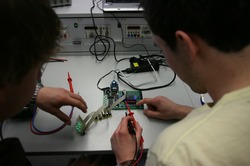
This illustrates one of the many important advantages of a S.T.E.M. curriculum: S.T.E.M. is hands-on instruction. Over the past few months we have been exploring an article by Sarah Wiggins titled “What is STEM and why should I teach it?”
In the article, Ms. Wiggins listed her top ten reasons for making STEM instruction the foundation for our math and science curriculum.
1. STEM has real world application
2. STEM fosters problem-solving skills
3. STEM is hands-on instruction
4. STEM is differentiated instruction
5. STEM promotes cooperative learning
6. STEM teaches creativity
7. STEM makes failure a learning opportunity
8. STEM involves high-level thinking
9. STEM requires students to be actively engaged
10. STEM is the future
In this month’s installment, I want to discuss this third component of hands-on instruction. I see many reasons to incorporate hands-on activities in our classrooms.
First, we all know students in general, and middle school students in particular, are bundles of energy. If they designed school systems, there would be less sitting in chairs and less listening to my rambling lectures. They want to move. In fact, I cannot tell who is engaged and who is not when they are sitting, but once they actively engage in a lesson, it is easy to see who is participating and who is off task.
There is much research to support the importance of physical engagement in learning, but for the sake of economy I would point the reader to chapter 4 of Eric Jensen’s, Teaching with the Brain in Mind. One of the many facts he cites is that the simple act of standing increases blood flow to the brain by 5 to 8 percent. I want my students active.
We know that the more engaged the student is, the more connections are being made. To hear an audio lecture on chemistry involves only one sense. To hear the lecture and see experiments doubles the buy-in. To hear, see, and do the experiments now makes the experience kinesthetic as well.
At a physiological level, learning is the process of creating synapses in the brain, of making new connections. I like to think of them as new highways under construction. These highways connect existing cities to new ones. I want a lot of road construction going on.
Lastly, the more physically engaged they are, the less I need to be. This doesn’t mean that I don’t play a role in the learning process – it just means that I have been freed up to do the task I love the most: guiding the process instead of pushing it. It’s like getting horses to pull a wagon on an expedition to new territory. I don’t want to have to push the cart while the horses watch. I want to see them rushing into new lands of discovery while I gently guide the reins.
 RSS Feed
RSS Feed